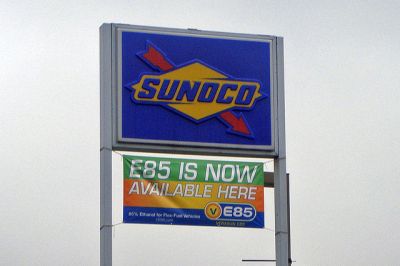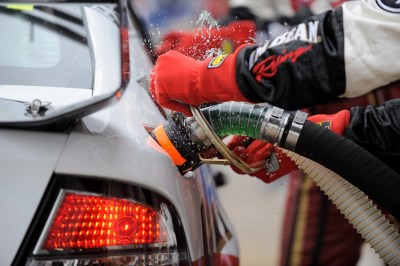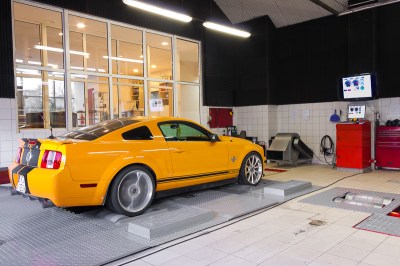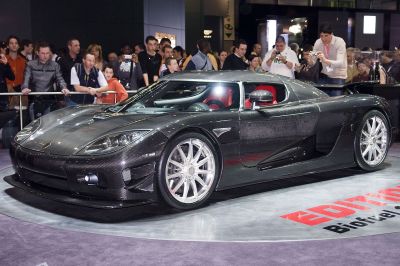If you’ve spent any time around the modified car scene in the last few years, you’ve probably heard about E85. Maybe you’ve even noticed a sweet smell emanating from the pitlane, or heard people cracking jokes about “corn juice.”
The blended fuel, which combines alcohol and traditional gasoline, can have significant performance benefits if used properly. Today, we’ll explore what those are, and how you can set your ride up to run on E85.
Pros and Cons
E85 is, nominally at least, a blend of 85% ethanol with 15% gasoline. In some countries, this is adhered to fairly religiously. However, in the United States, E85 that you get at the pump can be anywhere from 51% ethanol to 83%, with lower blends typically being delivered in cooler areas and during winter. This is due to the poorer cold start performance of ethanol-based fuels. However, if you’re buying drums of race-grade E85, you’re likely getting something much closer to that nominal ratio.

The main benefits of E85 fuel are simple and straightforward. Ethanol has a far higher octane rating than regular gasoline. Where the standard stuff comes in around 87, and premium pump gas gets up to 93, E85 fuel has an octane rating closer to 103-105 octane as per the (R+M)/2 measurement used in the USA.
Octane rating is important when it comes to knock resistance. Knock occurs when the fuel-air charge detonates instad of burning smoothly. Otto-cycle engines (i.e. gas engines) can be tuned to make more power by advancing the timing of the ignition spark, setting the fuel aflame as the piston is rising on the compression stroke. However, advance the timing too far, and burn the fuel-air charge too soon, and pressures in the cylinder can get too high, causing the fuel to detonate instead of burn in a more controlled manner. This can damage an engine very quickly.
Just as premium gas is more knock resistant than regular gas, E85 is even more knock resistant again. This allows an engine to be tuned with more ignition timing advance, as well as more boost in the case of forced-induction engines. Thus, it’s possible to tune an engine to make more power with E85 without experiencing damage from knock.

E85 also has a higher latent heat of vaporization than straight gasoline, meaning that as the fuel is injected into the engine, it absorbs more heat from the intake air. The cooler charge produces more power.
However, it’s not all win when it comes to running E85. E85 contains roughly 27% less energy per gallon than gasoline. This means that fuel economy is typically worse when running E85, in the vicinity of 20-30% worse in a properly-tuned vehicle. So to make the same power on E85, an engine must flow more fuel compared to gasoline. If you’re looking for a boost, flow rates go up even further.
The fuel is also hygroscopic, meaning it absorbs water from the atmosphere. This can give E85 a poor shelf life, as fuel that carries excess water content doesn’t perform as well. Worries about corrosion are typically overblown, but the fuel can have issues in some older fuel tanks, particularly those of composite materials. Older cars, typically from the 80s and before, may also have rubber fuel system components that degrade in the presence of ethanol, clogging fuel filters and injectors. However, cars from the late 90s onwards are typically all protected against this; hence the mainstream use of E10 gas across the world.
How To Reap The Benefits
So, you’ve read all about how E85 can give your engine more power, and you’re keen to take advantage. Great! However, unless you’re driving a car already tuned for flex fuel use, you’ll likely need to make some modifications. However, as hackers, that’s what we’re all about, so prepare to dive in.

The first thing your engine will need is a tune. If your car has a locked-down engine management system from the factory, you’ll likely need to go ahead and replace it entirely with a standalone tuneable ECU. Alternatively, some cars have tuneable ECUs from the factory if you have the right tools. Either way, you’ll need to be able to control spark timing and your fuel map to get the most out of E85.
Advancing the timing, and adding boost in forced induction applications, is how you unlock more power, while the fuel map must be tuned to account for the changes and make up for the lower energy value of E85. Dyno tuning is best, as it allows outside variables to be controlled, but the truly adventurous and experienced could always try a road tune instead.
You’ll also likely want to run a flex-fuel sensor so your ECU can deal with varying ethanol levels in the fuel. E85 pumps aren’t everywhere, and few of us fully drain our tanks when refilling them. Gas stations selling blends anywhere from 51 to 83% ethanol only adds to the confusion. If you pour in a 51% ethanol on top of a half-tank of straight gas, your functional octane level would be that of E25, somewhere in the mid-90s. If your tune expects an octane level of over 100, you’ll quickly get knock. A flex fuel sensor lets your car be tuned for straight gas and E85, and then interpolates depending on the detected ethanol level in the fuel lines.
Alternatively, if you’re running a car with a vintage ignition and carby setup, you’ll need to run some alcohol-safe fuel lines, twist the distributor for a bit more advance, and change the jets to flow more fuel. You may also want to get an E85 kit for your carb to ensure that old gaskets and seals don’t react with the ethanol. Alternatively, carbs designed to run E85 from the outset exist, designed specifically to handle the higher fuel flow required. However, there’s no easy way to do flex fuel with a carby setup, so if you tune for E85, don’t expect the car to run well or at all on regular gas anymore.

Beyond this, you may find your fuel system needs some modifications too. That 30% less energy density means your engine needs a lot more fuel than it did before, and if your fuel pump didn’t have a lot of headroom, then it could be quickly tapped out on E85. Thus, a bigger fuel pump is often key to switching over to run on E85. Similarly, if you’re finding your injectors are tapped out at 100% duty cycle and still aren’t flowing enough fuel, you may need to upgrade those to higher-flow units as well.
With all that done, you should have a car that’s happily running on E85. In naturally-aspirated applications, gains of around 5-10% are typical. It’s not a huge figure, but it can be useful in combination with other things like high-compression pistons, or it can help a highly-stressed race engine to run a little cooler.
However, with forced induction, E85 comes into its own. Its knock-prevention capabilities typically allow turbo and supercharged engines to run much more boost without incurring detonation. This extra air can then be mixed with more fuel for yet more power. A great example is the Koenigsegg CCX, which produced 806 horsepower on premium gasoline, while its sibling, the CCXR, put out 1018 horsepower, a full 25% more, running on E85.
Summary
If you’ve got a modern fuel-injected car, and a tuneable ECU, you could find switching to E85 one of the best bang-for-your-buck performance mods out there. However, if your car is one that needs major fuel system upgrades or a new engine management system to make the change, the value proposition might not stack up as well. Regardless, E85 is a great performance fuel, and there are gains to be had. If you decide to start running your car on corn sauce, we wish you good luck, and happy hacking!
















Around here (Southern Minnesota), E-85 is lower priced due to government lower taxes and alt-fuel subsidies.
I would buy it for the cost savings alone (I currently use E-15, 88 octane, 4 cents cheaper per gallon). But, the cost of any modifications would probably negate any fuel savings.
engine masters a show on t.v. in the states covered e85, newer cars (like year 2000+ cars if i remember) do not need modifications, nor does it damage the engine. Also e85 produces lots more power (like a lot more power) and at cooler temps and lower boost (E85 has a high oxygen content). So lets grow some hemp or Miscanthus × giganteus )and make bio fuel and puff puff pass. E85 engines and electric cars maybe? like a diesel electric train <- i don't know the pros or cons of that idea though.
for shame animal717 , you didn’t even read the article before commenting. I will now commence with self punishment. wrist->slap all good. went back and read it.
E15 at 4 cents off isn’t a great deal unless you’re only paying $1-2/gallon. You will get worse mileage on E15, but it’s minor: like 2-4 percent (small enough you’d never notice, but it is there). So 4 cents per gallon is definitely a (minor) loss.
Around here it’s a ton cheaper, like up to 10+ percent. That definitely makes sense.
4 cents less per gallon but you get 20 to 30 % worse fuel economy.
He said E15, not E85. E15’s typical drop is like 2-4% depending on what typical gas is in an area (i.e. E0 vs E10). Which still might not be a great deal.
When you get up to E85 the gas mileage difference is obvious and on average completely statistically consistent with volumetric energy difference. At the low end it’s extremely noisy due to other factors, but still consistent with energy, so it makes sense to just trust the physics in some sense.
Anyone have any experience with sensing knock detection to do a closed-loop spark advance setup?
I’ve been exploring advancing timing on my vintage sportscar and have been thinking about how to keep it from getting damaged if I screw up, and having something that tries to auto tune to retard timing if it sees knocking seems like a good idea.
(Also don’t you need higher compression in addition to advanced timing to take advantage of 100+ octane?)
Engine knock is pretty tough to sense amongst all of the noise already happening inside of an engine. ECUs often have tuned sensors (Which you could probably steal from a similar engine) some filtering on the input signal and some fancy algorithms to sort out the knock from normal stuff. I’ve never heard or seen anyone attempt it with a diy injector system (eg megasquirt) but it’s been a good 20 years since I was super interested in that stuff.
Quick Google search shows some promise in the megasquirt community: https://www.diyautotune.com/product/ms3-knock-module-kit/
A common misconception is that “Octane” requires a higher compression.
The reverse is true.
Higher compression requires higher octane.
Higher octane actually burns “SLOWER”, in an attempt to reduce pre-ignition/knock.
Higher octane has “Additives” to slow combustion.
Don’t rely on a safety to protect your engine. It’s like closed loop fueling. Use it as a tuning tool but have a tune that’s safe and run that. Have your safety’s pull timing or boost but don’t rely on them to generate a tune in real time. Just bad practice to do so. Knock sensors go bad, various mechanical parts can cause spurious readings or hide valid readings under the noise floor. Imho. I tried a fair few knock sensing gadgets over the years, always go back to a pair of headphones and a microphone bolted to the block. That said, you should be able to figure out the minimum advance for peak torque at the start of the torque plateau without going anywhere near knocking. (Another good reason not to use the advance till it knocks and back off a bit method)
You clearly know a ton more about this than I do: I was operating under the advance till it knocks tactic. How would I characterize the torque plateau region as a function of advance?
The problem with “Advance Till It Knocks” is it knocks before you can hear it.
I’m not sure how available in States but if you can buy Andoria 4C90 engines then go for it. Of course they are diesel but they are very reliable and easy to repair. Parts are cheap too (at least in EU and on Ukraine).
Just buy the eflexfuel conversion kit and few hours of elbowgrese later, all is ready… https://eflexfuel.com/us
“Worries about corrosion are typically overblown, but the fuel can have issues in some older fuel tanks, particularly those of composite materials.”
Anyone living in an area with relative humidity average above 80% is raising an eyebrow right now. That hygroscopic effect you talk about is incredibly fast when there is that much water in the air.
I’d never seen a fuel tank rust from the inside OUT before E15 came to town. Now, E15 will cause hard start issues if left untreated more than 3-4 weeks. I recommend all my part-time resident customers use fuel stabilizer and leave a full tank in their vehicle before parking for the summer.
I can’t recall seeing a composite tank corrode before, am I missing something?
Agreed. I had a friend who rebuilt motorcycle carbs for a living. The ethanol in “regular” gas could cause starting difficulties in bikes after just 4-6 weeks without use.
A lot of carbs use an alloy called ZiAl (a mix of zinc and aluminum). Zinc can be dissolved by ethanol, meaning that running a high-ethanol fuel through such a carb can be result in “pitting,” making the material brittle and porous.
Many older outboard engines used something similar. Ergo, if you have an older outboard motor (or an older mower or rototiller, for that matter), even E-10 can cause problems after several gallons run through the engine.
In Europe it’s hard to find anything lower than 95, with premium usually being 98, but you can get 102 in for instance Germany and I think I even remember getting 110 in Denmark.
Are the European measuring standards the same as the US though?
Good that you mentioned it. They aren’t. RON vs MON.
“The reason that European octane ratings seem higher than American ratings is because Europe, Japan and Australian only use the RON numbers. American and Canadian fuel uses an octane number derived from the average of the RON and the MON numbers. American fuel pumps have the designation R+M/2 to designation that the octane rating is RON plus MON divided by 2.
Simple math will show you that because of the 8 to 10 point difference of RON over MON, the octane rating shown on American fuel is approximately 5 points lower than the rating shown in Europe for the same fuel. In essence American 90-octane fuel would be the same as European 95 octane fuel.”
As if using imperial instead of metric wasn’t bad enough ;-)
nope
US does PON, EU does RON.
95 RON = 90.7 PON
98 RON = 93.5 PON
100 RON = 95.5 PON
I was privileged to train “First Responders” (Fire, Police, Tow Operators) on the hazards of alternative fuel traffic collisions.
As I recall, vehicles manufactured after a certain date were good for 10% Ethanol mixed gasoline. And yes, the lower BTU value of the 85% fuel was partially because ethanol is 30% Oxygen by weight, and while it supports combustion, it reduces mileage dramatically (As Stated Above)
Older vehicles had issues with corrosion, rotting fuel lines and other problems.
As you all know, ethanol seems to suck up moisture from the air, and that also is not a good thing.
My theory is, it’s truly a scam. While I was in Utah last October, they had 100% gasoline (no ethanol) available.
(Premium price though)
Anyway, enjoy your 85% garbage.
Did you even read the article?
Your comment is 85% garbage.
I strongly urge anyone reading this article to do some research about why E85 is available here. I think you will eventually come to the same conclusion I did: something doesn’t add up. The ethanol coming from corn, and those corn growers receive subsidies from the US government. Then, we have the issue of using farmland to produce fuel instead of food, while people in this same country go hungry. So, I believe the root of most of this mess is the inability of the average American to consume less. This country loves inexpensive gasoline, rampant consumerism, and revels in its own ignorance.
As I said, it’s a scam..
At least a 85% scam.
The Jury has spoken.
Any ideas on where to source E85 in the UK? Out in France it’s much cheaper for my 2001 petrol volvo and only difference is a 5mpg reduction and occasional stutter when starting on a cold morning.
Isn’t air/fuel ratio on ethanol like 4 to 1? while in gasoline is 16.5/1 ?
Shoulnd’t that require alot more fuel for the same power? or can an engine run a very poor mix and still produce power?
I remember cause racing 2t bikes used methanol/ethanol and required way more richer mixes on the carburator
It’s only about a 30% difference between straight gasoline and E85.
Ethanol ( E100 ) AFR is 9,7:1
Gasoline is 14.7:1
E85 is 15% Gasoline 85% Ethanol, you do the math !
How about an article on how the two methods of measuring fuel octane are done? There’s the Research method and the Motor method. Those are the R and M in the (R+M)/2 Method equation displayed on the gas station pumps. The pump octane number is a simple average of the Research and Motor methods’ numbers.
One thing water does to ethanol blended gasoline is it causes the gasoline and alcohol to separate, with the water absorbed by the alcohol. The gasoline will be floating on top of the water/alcohol mix. One way to combat that is with a surfactant, AKA soap. Here’s an experiment to try. Into a pair of graduated flasks with airtight seals, pour equal amounts of ethanol blend fuel. Add 1% water by volume. Then to one flask add a tiny amount of the clearest scent free dish soap you can find. Stir up both flasks, seal them then let them sit for a while to see what happens.
Google e85 fuel surfactant
That fruity smell coming from engines combusting E85 is Ethanal (Acetaldehyde) and it’s a major contributor to lung cancer and asthma attacks. It’s a major irritant at concentrations as low as 25 ppm, and it causes DNA damage. When the ECU hunts for the right A/F mixture, it belches out partially combusted ethanol, which contains Acetaldehyde, especially when the catalytic converter hasn’t warmed up properly.
It’s the same stuff that gives you a hangover when your liver has processed enough ethanol that it runs out of the enzymes to break it down completely, and it’s the reason why frequent heavy alcohol consumption causes cancer.
It’s downright hypocritical to wail and gnash teeth about diesel particulate matter and NOx pollution when state subsidized fuel is giving people lung cancer.
Oh. How i pity the us and canada: https://m.youtube.com/watch?v=uxykI30fS54
How could we hack that way of thinking so it turns out for the better.
And yes, i live in the Neterlands and i completely forgot how being a cyclist or pedestrian in the states is. For me the bike is on the front porch. Its a 1940’s transport bike with carrier capacity on the front wheel and just three gears. Brakes by threading the opposite direction. Although i live on a hill in the north of Arnhem (yes, from the bridge too far) i feel safe enough that I never felt the need to wear a helmet.
For longer trips i take the car, but that may be just once a week. Groceries are done on the bike.
In Finland and Sweden you can buy an E85 conversion kit for cars with direct fuel injection. It basically connects between ECU and injectors to extend the injection time, while the ECU still does what it does best. Later models also include ethanol fuel sensor and cold start assist. Sources: https://fuelflexfinland.fi/en/ and https://e85konvertering.se/